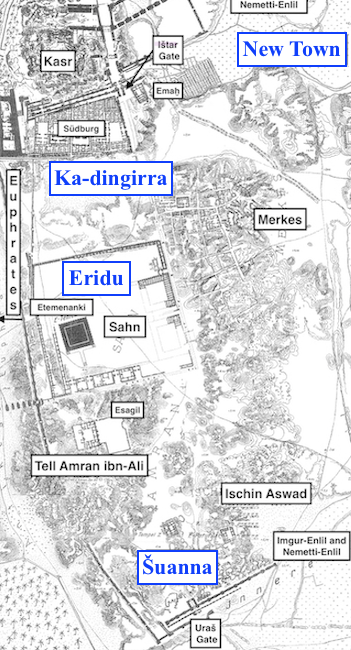Babylon

Babylon (Akkadian Bābili), whose ruins are situated ca. 90 km south of Baghdad, was the principal cult center of the god Marduk, an obscure local deity who not only became one of the most important Mesopotamian gods, but also the "king of the gods." The city — which is first mentioned as BAR.KI.BAR in the late third millennium BC and which first became a powerful and influential city-state under the Old-Babylonian king Hammu-rāpi (r. 1792–1750), the sixth king of the First Dynasty of Babylon — reached its heyday in the sixth century BC, when the Neo-Babylonian king Nebuchadnezzar II (r. 604–562 BC) transformed it into an imperial megacity, thereby making it "an object of wonder for all of the people to see." The glory and legacy of Babylon — whose fifty names and topography are recorded in the five-tablet scholarly compendium Tintir = Babylon, a text likely composed in the twelfth century BC — together with its principal temple Esagil, its lofty temple-tower Etemenanki (which is equated with the biblical Tower of Babel), its grand palaces, and its rectangular-shaped inner and outer walls Imgur-Enlil and Nēmetti-Enlil, survived long after native rule of Babylonia came to an end in 539 BC; stories/information about the city and some of its most important monumental architecture are know from the Bible and in Classical texts, which list the city's walls or "Hanging Gardens" among the seven wonders of the ancient world.

Annotated plan of the ruins of East Babylon. Adapted by Jamie Novotny from Koldewey, Das wieder erstehende Babylon, fifth edition, fig. 256.
Babylon was a city that was divided in two halves. The Arahtu River, an arm of the Euphrates River that corresponds to the modern Šaṭṭ al-Ḥillah, separated East Babylon from West Babylon. According to Tablet V of the scholarly compendium Tintir = Babylon, Babylon's inner city (at least from the twelfth century BC onwards) had ten city quarters: Eridu, Šuanna, Ka-dingirra, New City, Kullab, and TE.E (exact reading uncertain) were in East Babylon, while Nu... (name damaged), Kumar, Bāb-Lugalirra, and Tuba were in West Babylon. The inner city was surrounded by the main wall Imgur-Enlil and the outer wall Nēmetti-Enlil. Eight gates, four on each side of the Arahtu River, provided access to the numerous temples, daises, shrines, and stations of Babylon's gods and goddesses, as well as to the king's royal residence(s).
At least in the first half of the first millennium BC, the Eridu, Ka-dingirra, and Šuanna districts were the most important parts of the city. Šuanna, which stretched from "the Market Gate to the Uraš Gate," was home to two temples. Eridu, the most important part of Babylon, which ran from "the Market Gate to the Grand Gate," housed fourteen temples, including its two most important religious structures: Esagil and Etemenanki, the temple and ziggurat of Babylon's divine patron, the god Marduk. In Ka-dingirra, whose southern and northern boundaries were the Grand Gate and the Ištar Gate, there were four temples, as well as the king's principal royal residence (the so-called South Palace). Many of these buildings in East Babylon were excavated by German and Iraqi archaeologists, most notably by Robert Koldewey on behalf of the Deutsche Orient-Gesellschaft (DOG) and Königliche Museen Berlin (KMB) in 1899–1917. Due to the high level of the groundwater at Babylon, it has been impossible in many parts of the city to explore occupation levels and building phases earlier than the Neo-Babylonian Period and, thus, much of Babylon's architectural history prior to the reigns of Nabopolassar (r. 625–605 BC) and Nebuchadnezzar II (r. 604–562 BC) is now permanently lost. The names of many of the Babylonian (and Assyrian) kings who sponsored construction of the city's most important structures did not stand the ravages of time. Fortunately, a great deal about Babylon during its imperial heyday is known.
Many of Babylon's city gates, city walls, palaces, and temples are presently discussed on BTMAo. Click on the links above or in the website menu to access information about these architectural features.
Banner image: plan and reconstruction of Babylon with the excavated temples and unexcavated temples shown according to their city districts according to Tintir = Babylon Tablet IV. Adapted from O. Pedersén, Babylon: The Great City, fig. 4.2.
Jamie Novotny
Jamie Novotny, 'Babylon', Babylonian Temples and Monumental Architecture online (BTMAo), The BTMAo Project, a sub-project of MOCCI, [http://oracc.org/btmao/Babylon/]